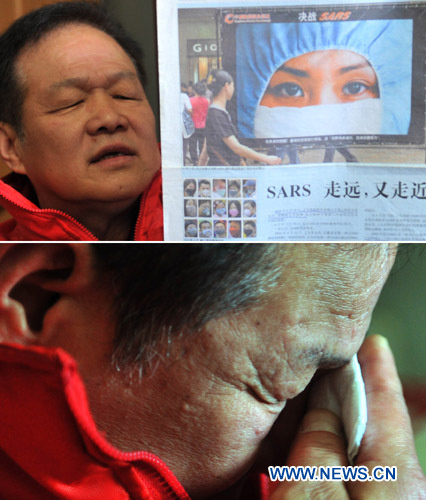
This combined photo take on April 8, 2013 shows Fang Bo holding an outdated newspaper issued during the time when SARS was epidemic (top) and he weeps while being reminded of the hard time with SARS. (Xinhua/Li Wen)
ENDLESS PAIN
Fang was grateful for his survival. Three days after he was discharged, he took his surviving family members to donate blood serum, which is rich in antibodies and can aid in the development of vaccines.
But SARS has left him with not only grief over his departed wife, but also great physical pain that will likely last the rest of his life and eventually confine him to a wheelchair.
Only six months after his recovery, Fang came down with acute pain in the legs. He went back to the hospital and was told he was suffering osteonecrosis in both thighbones, a serious condition in which the bone can die.
"When I told the doctor I was treated for SARS, he said 'that's why'," Fang said.
Fang has read a description of Sou-Medrol, the hormone drug he was dosed with while being treated. The description lists more than 30 adverse reactions, including osteoporosis, osteonecrosis, high blood pressure and mental disorders.
"Even normal doses cause many potential hazards," said Fang, who was given 10 to 15 times the normal dose to bring down his persistent high fever.
More than 2,500 people in Beijing were diagnosed with SARS in the spring of 2003, of whom 2,280 recovered and nearly 200 died. Most of the critical patients received large doses of Sou-Medrol, which was the only way to relieve their high fevers and save their lives.
Fang was diagnosed with severe osteonecrosis in both thighbones in January 2004 and received two replacement surgeries from December 2005 to February 2006.
But the treatment did not promise long-lasting effects. "The material used for the replacement lasts only 15 years, by the end of which time I will need another surgery," he said.
Worse still, his osteonecrosis is systemic. Even before his thighbones were properly treated, the pain in his shoulders had become unbearable, followed by his knees, elbows and wrists.
"The pain is constant and I have to rely on painkillers. My doctor says it's a 'cancer that does not kill' and will torture me for the rest of my life."

Copyright ©1999-2011 Chinanews.com. All rights reserved.
Reproduction in whole or in part without permission is prohibited.